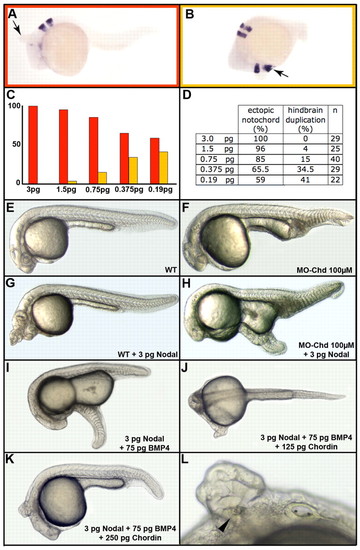Fig. 6
- ID
- ZDB-FIG-091120-6
- Publication
- Fauny et al., 2009 - The entire zebrafish blastula-gastrula margin acts as an organizer dependent on the ratio of Nodal to BMP activity
- Other Figures
- All Figure Page
- Back to All Figure Page
|
Interaction between endogenous BMP activity and ectopic Nodal signaling at the animal pole. (A-L) Injection of 3 pg nodal RNA at the animal pole results in the induction of ectopic axial structures (A, arrow). When lower amounts are injected, partial secondary axes extend posteriorly up to the hindbrain (B, arrow). The bar graph in C, built from data presented in D, presents the percentage of notochord (red) or hindbrain (orange) duplication as a function of the amount of nodal RNA injected. Owing to the presence of endogenous BMP activity at the animal pole, the progressive decrease of nodal RNA mimics the BMP/Nodal ratio present from the dorsal to the lateral margin. n, number of embryos analyzed. Wild type (WT, E) and chordin morphant (MO-Chd, F) embryos. Injection of 3 pg nodal RNA at the animal pole of WT embryos results in the formation of an ectopic notochord (G), whereas injection of the same amount in the chordin morphant results in formation of a secondary tail (H). Injection of 3 pg nodal and 75 pg bmp4 RNAs into wild type embryos results in formation of a secondary tail (I). Co-injection of 125 pg chordin RNA changes this posterior structure into a secondary trunk (J), whereas co-injection of 250 pg chordin RNA results in the formation of posterior head structures (K,L, with a secondary otic vesicle, arrowhead). Lateral view, anterior to the left and dorsal to the top. |

